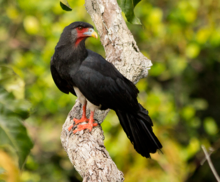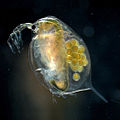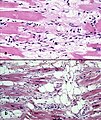GLAM/Newsletter/December 2013/Contents/Open Access report
|
NISO cites GLAM Newsletter; Adoption of CC BY 4.0;
Two years Open Access File of the Day


NISO cites GLAM Newsletter and invites your comment
The Workgroup on Open Access Metadata and Indicators (OAMI) at the National Information Standards Organization have recently released draft recommendations for how to signal information pertaining to the use and reuse rights of scholarly articles. These include
- a
<free_to_read>tag intended to signal whether and when a publication is available publicly without a requirement for payment or registration - a
<license_ref>tag intended to point to a URI containing the licensing terms - no definition of the term Open Access
- no specification as to which licenses are allowed, or whether and how they should be version-controlled
- no provision for icons that may be suitable for signaling the content of the proposed tags.
WikiProject Open Access is working on a Wikimedia version of such a signaling of licensing information, intended to be compatible with the NISO recommendations but more geared towards openness.
Of note, the document contains a use case very similar to that of the Open Access Media Importer (by coincidence, also abbreviated OAMI):
A user wishes to use visual images from an article, either in a single case or in some automated re-use pipeline. Acting in good faith, the user seeks licensing information, e.g., at PubMed Central or a similar source, to ascertain his/her rights. However, in some cases the article licensing metadata is contradictory or incorrect. For example, an article might be properly licensed under CC BY, but the publisher (or whoever is adding metadata) is making conflicting licensing statements or identifies other restrictions not provided for in the license.1
The reference is incorrectly formatted but intended to go to the November 2012 Open Access report in this very GLAM newsletter. The NISO document is open for comments until February 4.
Adoption of CC BY 4.0
On November 25, Creative Commons released version 4.0 of their license suite. The implications for science publishing and the CC BY license prevailing therein have been explained a few weeks later in a dedicated blog post by Puneet Kishor that accompanied BioMed Central's have announcement that, from February onwards, all of the manuscripts accepted by them or by Springer Open shall be published under the Creative Commons Attribution 4.0 License (CC BY 4.0) that became available in late November and has since been determined to be compliant with the Open Definition. Other publishers have already implemented the change: of the currently 885 files in Category:CC-BY-4.0 on Wikimedia Commons, about one third (297) come from open access sources — 236 from PLOS and 61 from Pensoft.
Two years Open Access File of the Day
On December 1 in 2011, the first Open Access File of the Day was posted, and one file per day ever since. These files highlight the potential for reuse of scholarly materials in educational contexts, as well as the need for scholarly publications to be made available under open licenses to make that happen. Together, these 700+ files are used across 200 Wikimedia projects on over 30,000 pages that together gather on the order of 20 million page views per month.
The following files have been featured as Open Access File of the Day this month:
-
December 31: the frog Platymantis polillensis
-
December 30: Computer simulation of the development of retinal axons in the superior colliculus.
-
December 29: a male Copa flavoplumosa spider
-
December 28: Orobanche purpurea.
-
December 27: A whirligig beetle swimming
-
December 26: the gekko Thecadactylus oskrobapreinorum
-
December 25: Kaprosuchus saharicus skull. Scale bar: 10 cm.
-
December 24: Astaxanthin buildup during growth of a microbial cyst.
-
December 23: Müller glia (red) interdigitated with retinal microglia (green).
-
December 22: The beetle Cratacanthus dubius.
-
December 21: the cichlid Maylandia zebra
-
December 20: The moth Idalus paulae.
-
December 19: the butterfly Pseudophilotes bavius
-
December 18: x-ray showing esophageal atresia
-
December 17: Meioglossus psammophilus, the acorn worm
-
December 16: drawing of the freshwater clam Pisidium nitidum
-
December 15: the lizard Cyrtodactylus philippinicus
-
December 14: the coral Corallium konojoi
-
December 13: the water flea Daphnia magna
-
December 12: Sequential tool use by a New Caledonian Crow.
-
December 11: The bivalve Solemya elarraichensis.
-
December 10: Titanosauria building a nest
-
December 9: the biochemist Kai Simons
-
December 8: histologic specimen showing arrhythmogenic right ventricular dysplasia
-
December 7: the butterfly Euphydryas maturna
-
December 6: CT scan of Mastacembelus platysoma head.
-
December 5: bones of the dinosaur Martharaptor
-
December 4: Deinodryinus velteni.
-
December 3: cricket of family Gryllacrididae spinning silk
-
December 2: the marine worm Osedax roseus
-
December 1: Aptostichus angelinajolieae.
Featured content
- December 31: A video of a leaping Alticus arnoldorum fish is embedded in a Scientific American post describing new research about the evolution of the camouflage colour pattern of the species. The attribution in the post to Wikimedia Commons highlights the role that Commons can play in amplifying the outreach potential of materials published in scholarly outlets.
- December 31: A video of the four-cell alga Tetrabaena socialis is featured (WebCite archive) on the Main Page of Wikimedia Commons under Media of the Day. It was originally published in PLOS ONE earlier this month and uploaded to Commons by the Open Access Media Importer Bot. Traffic stats: Main Page, video.

- December 24: The article on Flow cytometry bioinformatics is featured in the Did you know section on the Main Page of the English Wikipedia (WebCite copy). The article is the sixth in the Topic Page series of PLOS Computational Biology: published earlier this month in the journal, it went on to become this Wikipedia article — that way, the article starts at a very high quality level and can be revised as new information becomes available about the topic. Traffic stats.
Open Access Media Importer
The following represents a selection of the ca. 400 files that have been uploaded by the Open Access Media Importer this month, bringing the total to over 14,900. If you can think of wiki pages where these files could be useful, please put them in there or let us know.
| Home | About | Archives | Subscribe | Suggestions | Newsroom |

























